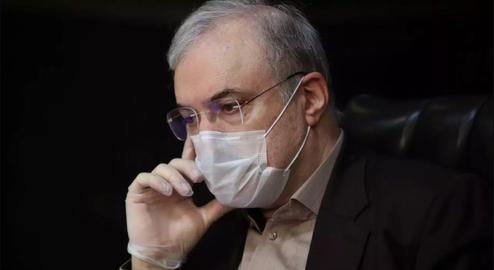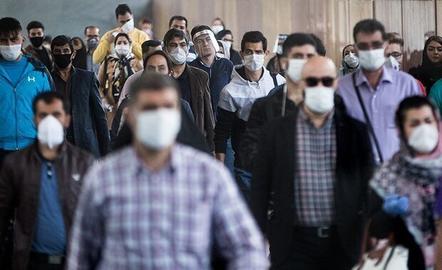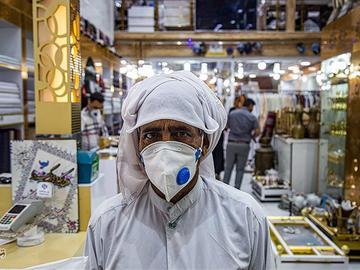Officials have warned that Iran’s coronavirus crisis could veer out of control if the situation does not improve soon in Tehran province and 20 other provinces, adding that there was also a risk of public unrest.
The Tehran Coronavirus Taskforce held an emergency meeting on July 8 to discuss the health, security and economic risks. Health Minister Saeed Namaki said he had a duty to both safeguard people’s health and their livelihood, and that he was aware that hungry people were liable to rebel.
“The security reports that we receive confirm that people are moving toward rebellion out of poverty and destitution,” Namaki said. “This is serious. The president and security forces must think about people’s livelihoods and how to prevent a rebellion.”
Over the last three weeks, the number of infections in the provinces of Khuzestan, Bushehr, Hormozgan, Kurdistan, Kermanshah, West Azerbaijan and East Azerbaijan has increased, reported deputy health minister Ghasem Jan-Babaei.
However, along with these acknowledgments and warnings, Namaki insisted that his ministry had followed the right course of action, placing blame for the current crisis on people who had shown negligence, “both the people and friends who hold positions within the government and in the private sector.”
As part of his claim that the government had acted responsibly and effectively, Namaki said that Iran had been the first country to suspend international flights on January 27 and that the country had designed the PCR (polymerase chain reaction) testing method before anybody in the world had come up with a coronavirus test kit. International media reports about Iran’s handling of the crisis and a review of IranWire’s coronavirus chronology make it clear that both these claims are baseless.
Another of Namaki’s deflective strategies was flattering Ayatollah Khamenei and indirectly but strongly criticizing President Rouhani, accusing him of putting the economy first. “Instead of telling us ‘don’t worry, go after the disease and we will uphold the economy,’ they wanted us...to work more on the livelihood of the people than on their health,” he said. “They should have written guidelines telling us how to reopen instead of...telling us how to shut down.”
Crumbling Infrastructure and Lack of Investment in Khuzestan
One of Iran’s deputy health ministers, Ghasem Jan-Babaei, denied the situation was worse than it had been in March, despite health officials in a number of provinces reporting that intensive care units (ICU) and beds for coronavirus patients had been filled to capacity. Jan-Babaei denied the reports of a shortage of beds, claimed that the necessary equipment had been supplied to the provinces, and said it was not necessary to dispatch mobile hospitals as it had been previously.
Reporting on Khuzestan province, Farhad Abolnejadian, the president of Ahvaz University of Medical Sciences, said the province was not experiencing a shortage of ICU beds, but that the situation was serious and if the number of critically-ill patients grew, there would be no available beds for them.
Abolnejadian pointed to Khuzestan’s crumbling infrastructure, and in particular its fragile medical infrastructure, the legacy of several years of under-investment in the province. The health ministry had provided some hospitals with oxygen concentrators, he said, adding: “We are trying to get them for other hospitals,” while acknowledging that the equipment was prohibitively expensive.
On the same day, Mohammad Alavi, vice president of Ahvaz University of Medical Sciences, announced that Khuzestan was one of the most dangerous places in the country, and that it had been among the “red” or high-danger-zone provinces for the last seven weeks. Although the number of Covid-19 cases in Khuzestan had declined over the last two or three weeks, this decline is temporary, he said.
Capital in Crisis
Despite numerous warnings by health officials, the situation in Tehran is again critical.
Posting on Twitter, Ali E'ta, Tehran City Council’s spokesman, described the situation in Tehran as “extremely deplorable” and the rapid increase in the number of patients and fatalities as “astonishing.” He called on the Coronavirus Taskforce to impose the strictest restrictions without delay.
Anooshirvan Mohseni Bandpey, the governor of Tehran province, said that, due to the complexities specific to Tehran, it would be very difficult to control the situation if it became more critical and was classified as a “red” or danger zone.
According to information sent exclusively to IranWire, over the last three days, the bodies of of 220 coronavirus victims have been handed over to Tehran’s Behesht Zahra Cemetery. The same data shows a total of 6,243 Covid-19 patients have died in Tehran since February 20.
Dr. Alireza Zali, director of the Tehran Coronavirus Taskforce, called for the cancelation of in-person university exams, the reduction of office hours to 50 percent the normal amount and the re-imposition of restrictions in the capital. According to Zali, in the last 48 hours the number of people with symptoms of Covid-19 arriving at hospitals and medical centers reached a new high. Over the last 10 days the number of coronavirus infections and fatalities has increased.
The situation in Tehran became so critical that Deputy Health Minister Ghasem Jan-Babaei was forced to order the city’s three universities for medical sciences, which oversee clinics and hospitals, to admit patients with coronavirus symptoms. The only medical centers exempt are single-specialty hospitals. If the centers do not have available beds, these patients must be admitted to other treatment centers linked to the three universities.
Official Figures Well Below Actual Numbers
On several days up to 300 patients in Iran had lost their lives to coronavirus each day, said Mohammad Ali Mohseni Bandpey, a member of the parliament’s Health Committee, adding that health ministry statistics are lower than the actual figures because they refer to patients who die in hospitals and do not include people who die at home or on their way to the hospital.
Deputy Health Minister Ghasem Jan-Babaei said that more restrictions might be re-imposed in Mashhad’s metropolitan area. This, he said, was the only way one could expect the epidemic to subside. He added that it was the National Coronavirus Taskforce that had to decide on severe restrictions.
Every day approximately 600 coronavirus tests are conducted in centers run by Mashhad University of Medical Science and around 35 to 40 percent of the tests are positive, reported Mohammad Hasan Darakhshan, a senior official at the university. This means that in the city of Mashhad alone, close to 240 new coronavirus cases had been identified each day.
Every two and a half hours a coronavirus patient dies in the province of Kermanshah, according to the provincial governor Houshang Bazvand. The rate of coronavirus infections in the province of Kermanshah has been steady over the last week and has not increased, but he warned that the province was still in a “red” or dangerous state, with 380 Covid-19 patients in hospitals.
Since the outbreak of coronavirus in Iran, approximately 20 percent of the population of Ardebil province has been infected, said Ramin Maboudi, president of Ardebil Red Crescent Society. If this number is accurate, it would mean that, as of July 8, close to 260,000 of Ardebil’s population of 1.3 million have been infected with coronavirus.
In the last 24 hours, from July 7 to July 8, 2,691 new coronavirus patients have been identified, bringing the total number of cases in Iran to 248,379, according to Sima Sadat Lari, the spokeswoman for the health ministry. Of the new cases, 1,455 have been hospitalized and during the same 24-hour period 153 Covid-19 patients died, increasing the total death toll to 12,084.
According to Dr. Sadat Lari, the provinces of Khuzestan, Hormozgan, Bushehr, Kermanshah, Kurdistan, Ilam, West Azerbaijan, East Azerbaijan and Razavi Khorasan are in a “red” state or a state of emergency and the provinces of Tehran, Isfahan, Mazandaran, Golestan, Alborz, Kerman, Yazd, Sistan and Baluchistan, Hamedan and Ardebil are on alert.
As has been the case throughout Iran's coronavirus crisis, officials have presented contradictory reports and statistics, and even classified the alert levels in provinces in different ways. In one clear example, Sadat Lari described Golestan province as being “on alert,” whereas the president of Golestan University of Medical Sciences officially announced that the province is in a “red” state, or a state of emergency.
First-Degree Murder Charges for Hosting Weddings or Mourning Ceremonies
To cope with the upsurge of coronavirus, mourning and wedding ceremonies were banned in the province of East Azerbaijan, Mahboub Alilou, East Azerbaijan’s prosecutor, announced. He warned that if such a ceremony takes place, the site where it did will be sealed, and if anyone who attended the ceremony has contracted coronavirus, the organizer and the owner of the site will be held criminally accountable and face civil charges as well, which could result in fines and charges for inflicting bodily harm or even for first-degree murder.
With a resurgence of the coronavirus epidemic in the city of Saghez in Kurdistan, strict public health regulations are due to be imposed on the city. Those who endanger people’s safety cannot be treated with lenience, said Kamil Karimian, the governor of Saghez. According to official health ministry’s statistics, as of July 8, 70 Covid-19 patients had died in Saghez.
Danger Spots Suffer Similar Problems
On July 8, there were 700 coronavirus patients hospitalized in the northern province of Mazandaran. According to the latest figures released by the Babol University of Medical Sciences, the city of Babol had record-breaking numbers of confirmed Covid-19 cases and Babol was designated a red zone on Saturday, July 4. During the first wave of the epidemic, Babol was one of the hardest-hit cities in Iran and had been an epicenter of the epidemic after the initial outbreak. In the last week, the number of patients in the province had increased by 50 percent. Senior Deputy Health Minister Iraj Harirchi urged people not to travel there.
Provinces with high numbers of cases and where cases are mounting steadily report similar problems. Stating that in the last week the number of Covid-19 patients with acute respiratory syndrome had increased in the province, Touraj Asadi, vice president of Mazandaran University of Medical Sciences, warned that its hospitals could, like Khuzestan, face a shortage of ICU beds. Over the last two weeks, the number of coronavirus patients in Mazandaran had doubled to around 650, he said.
Asking for new restrictions to be imposed in the cities of South Khorasan province, Mahmoud Dehghani, president of Birjand University of Medical Sciences, reported that the number of patients suffering from acute respiratory syndrome in the province had increased by 2.5 times compared to the last surge of coronavirus. Currently, he said, more than 218 of them are hospitalized.
In Fars province, two-digit numbers of coronavirus fatalities in one day caused alarm, with Alireza Mir Ahmadizadeh, vice president of Shiraz University of Medical Sciences, warning the number of infections in the province had reached a disturbing level as well.
The cities of Gorgan and Azad Shahr joined other cities reporting a high rate of coronavirus infections in Golestan province, and Abdolreza Fazel, the president of Golestan University of Medical Sciences, said the province was now in a “red” state or a state of emergency. He reported that the number of hospitalizations in the province had exceeded 750 and daily hospitalizations had increased from 50 to 100. However, the health ministry spokesperson's assessment of Golestan was slightly different: Dr. Sadat Lari referred to the province as being simply "on alert."
This is part of IranWire's coronavirus chronology. Read the full chronology
visit the accountability section
In this section of Iran Wire, you can contact the officials and launch your campaign for various problems




























comments